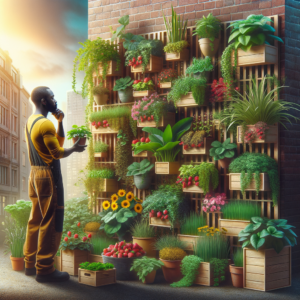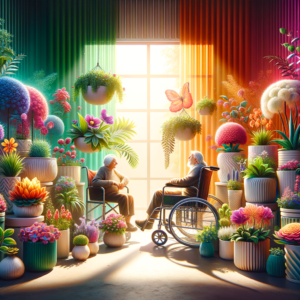Gardening is a rewarding activity that offers numerous physical and mental health benefits. However, for individuals with mobility issues, chronic pain, or limited time, traditional gardening can be challenging. Enter self-watering containers – an innovative solution that’s revolutionizing adaptive gardening. This comprehensive guide explores how self-watering containers can make gardening more accessible and enjoyable for everyone.
Understanding Self-Watering Containers
Self-watering containers, also known as sub-irrigated planters, are designed with a built-in reservoir that supplies water to plants as needed. Here’s how they typically work:
- Water Reservoir: A compartment at the bottom of the container holds water.
- Wicking System: A wick or capillary mat draws water up from the reservoir to the soil.
- Soil Chamber: Where plants grow, separated from the water reservoir by a perforated platform.
- Fill Tube: Allows easy refilling of the water reservoir.
- Overflow Hole: Prevents overwatering by allowing excess water to drain.
This system maintains consistent soil moisture, reducing the frequency of watering.
Benefits of Self-Watering Systems for Adaptive Gardening
- Reduced Physical Strain: Less frequent watering means less bending, lifting, and carrying water.
- Consistent Moisture: Prevents under or overwatering, common issues for those with limited mobility.
- Extended Watering Intervals: Ideal for individuals who may forget to water or have difficulty doing so regularly.
- Improved Plant Health: Consistent moisture leads to healthier, more robust plants.
- Water Conservation: Minimizes water waste through evaporation and runoff.
- Versatility: Can be used indoors or outdoors, making gardening accessible year-round.
- Portability: Many designs are lightweight and easy to move.
- Reduced Risk of Water Spills: Particularly beneficial for indoor gardening.
Types of Self-Watering Containers
- Double-Pot Systems: An inner pot with drainage holes sits in an outer pot that holds water.
- Reservoir Planters: All-in-one containers with built-in water reservoirs.
- Wicking Beds: Larger raised beds that use a wicking system to distribute water.
- Vertical Self-Watering Systems: Stackable or wall-mounted planters with integrated watering.
- Self-Watering Hanging Baskets: Ideal for trailing plants and small spaces.
- Smart Self-Watering Planters: High-tech options with sensors and automated watering.
How to Choose the Right Self-Watering Container
Consider these factors when selecting a self-watering container:
- Size: Match the container size to your plants’ needs and available space.
- Material: Options include plastic, ceramic, metal, and fabric.
- Water Capacity: Larger reservoirs mean less frequent refilling.
- Ease of Setup and Maintenance: Look for user-friendly designs.
- Mobility Features: Wheels or lightweight materials for easy movement.
- Aesthetics: Choose containers that complement your space.
- Indoor vs. Outdoor Use: Ensure the container is suitable for your intended location.
- Cost: Balance initial investment with long-term benefits.
Best Plants for Self-Watering Containers
- Vegetables: Tomatoes, peppers, lettuce, spinach, herbs
- Flowers: Petunias, impatiens, begonias, marigolds
- Houseplants: Pothos, spider plants, peace lilies, African violets
- Small Fruits: Strawberries, dwarf blueberries
- Succulents: Be cautious with drainage to prevent overwatering
- Tropical Plants: Many thrive with consistent moisture
Avoid plants that prefer dry conditions or are prone to root rot.
Setting Up Your Self-Watering Container
- Prepare the Container: Clean and assemble according to manufacturer instructions.
- Add Soil: Use a high-quality potting mix designed for container gardening.
- Install the Wick: Ensure good contact between the wick and soil.
- Plant Selection: Choose plants with similar water needs for each container.
- Planting: Follow proper spacing and depth guidelines for your chosen plants.
- Initial Watering: Water from the top until the reservoir is full.
- Add Fertilizer: Use a slow-release fertilizer appropriate for your plants.
Maintenance and Care Tips
- Regular Checks: Monitor the water level in the reservoir.
- Cleaning: Periodically clean the reservoir to prevent algae growth.
- Fertilizing: Use liquid fertilizer in the reservoir or slow-release granules in the soil.
- Pruning: Maintain plant size appropriate for the container.
- Seasonal Care: Adjust watering frequency based on weather and plant growth.
- Winter Preparation: Protect outdoor containers from freezing.
Troubleshooting Common Issues
- Overwatering: Ensure the overflow hole is clear; consider adding more drainage.
- Underwatering: Check if the wick is properly connected to the reservoir.
- Algae Growth: Clean the reservoir and limit light exposure to the water.
- Pest Infestations: Regularly inspect plants and treat as needed.
- Salt Buildup: Flush the system periodically with clean water.
DIY Self-Watering Container Ideas
- Plastic Bottle System: Create a small self-watering planter using recycled bottles.
- Bucket Garden: Convert a 5-gallon bucket into a self-watering container.
- Wicking Bed: Build a large raised bed with a reservoir and wicking system.
- Milk Jug Planter: Repurpose plastic jugs for small herbs or flowers.
- PVC Pipe Garden: Construct a vertical garden with built-in watering.
Environmental Impact and Water Conservation
Self-watering containers contribute to water conservation by:
- Reducing water waste through evaporation and runoff
- Encouraging deep root growth, leading to more drought-resistant plants
- Allowing for the use of collected rainwater or greywater in some systems
Conclusion
Self-watering containers are indeed a game-changer for adaptive gardening, offering a blend of convenience, accessibility, and improved plant care. They make gardening possible for individuals who might otherwise find it challenging, while also benefiting those looking for low-maintenance options. By providing consistent moisture, reducing physical strain, and conserving water, these innovative planters open up the joys of gardening to a wider audience.
Whether you’re dealing with mobility issues, time constraints, or simply want to optimize your gardening experience, self-watering containers offer a practical and rewarding solution. As you embark on your adaptive gardening journey, remember that the key to success lies in choosing the right container, selecting appropriate plants, and maintaining your system with care. Happy gardening!
FAQ
- Q: How often do I need to refill a self-watering container? A: It varies based on container size, plant type, and climate, but many systems need refilling every 1-2 weeks.
- Q: Can I use self-watering containers for indoor plants? A: Yes, they’re excellent for indoor use, reducing the risk of water damage to floors and furniture.
- Q: Are self-watering containers suitable for vegetable gardening? A: Absolutely! Many vegetables, especially those that like consistent moisture, thrive in self-watering containers.
- Q: How do I prevent mosquitoes from breeding in the water reservoir? A: Use mosquito dunks or ensure the reservoir is covered to prevent mosquito access.
- Q: Can I use regular garden soil in a self-watering container? A: It’s best to use a high-quality potting mix designed for container gardening to ensure proper drainage and aeration.



